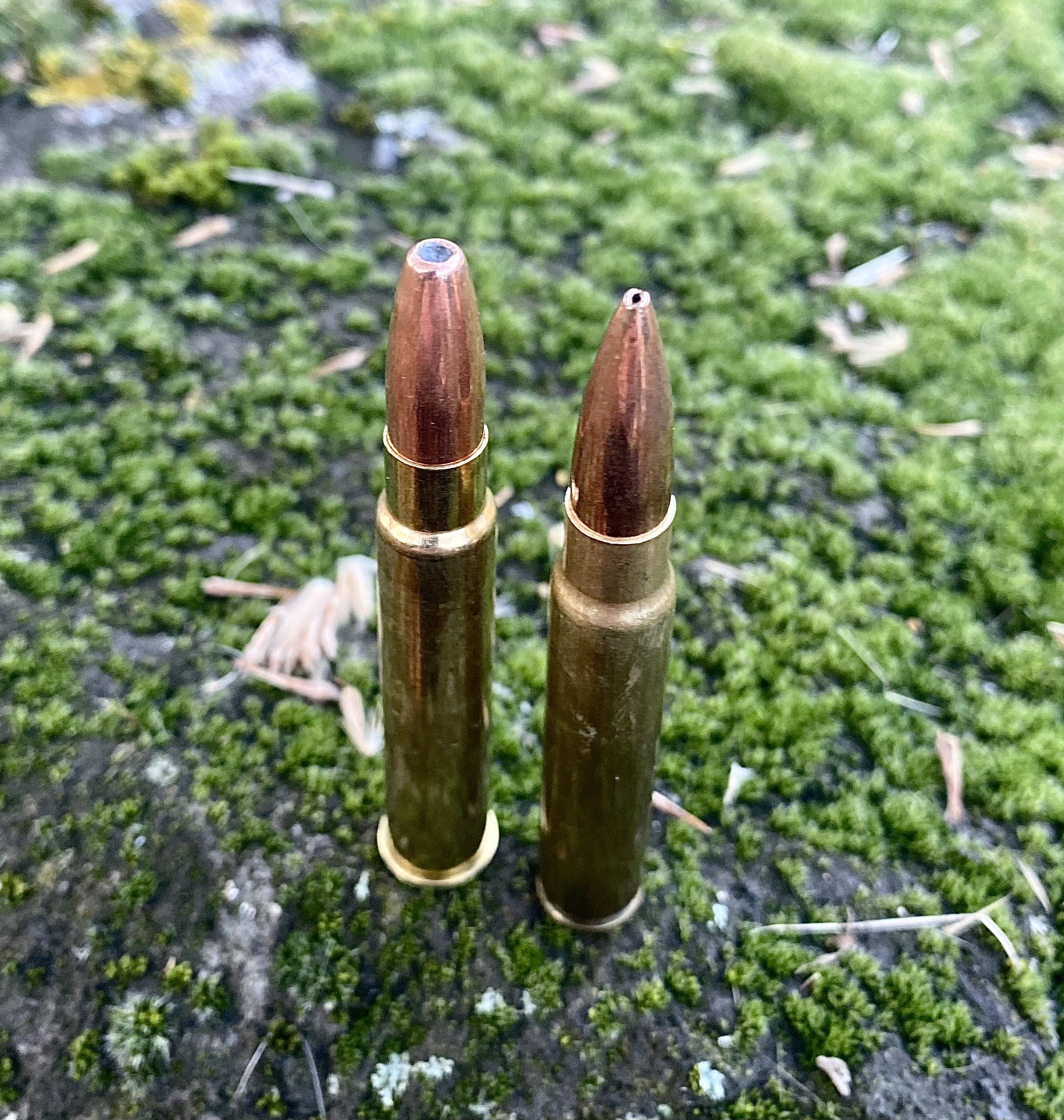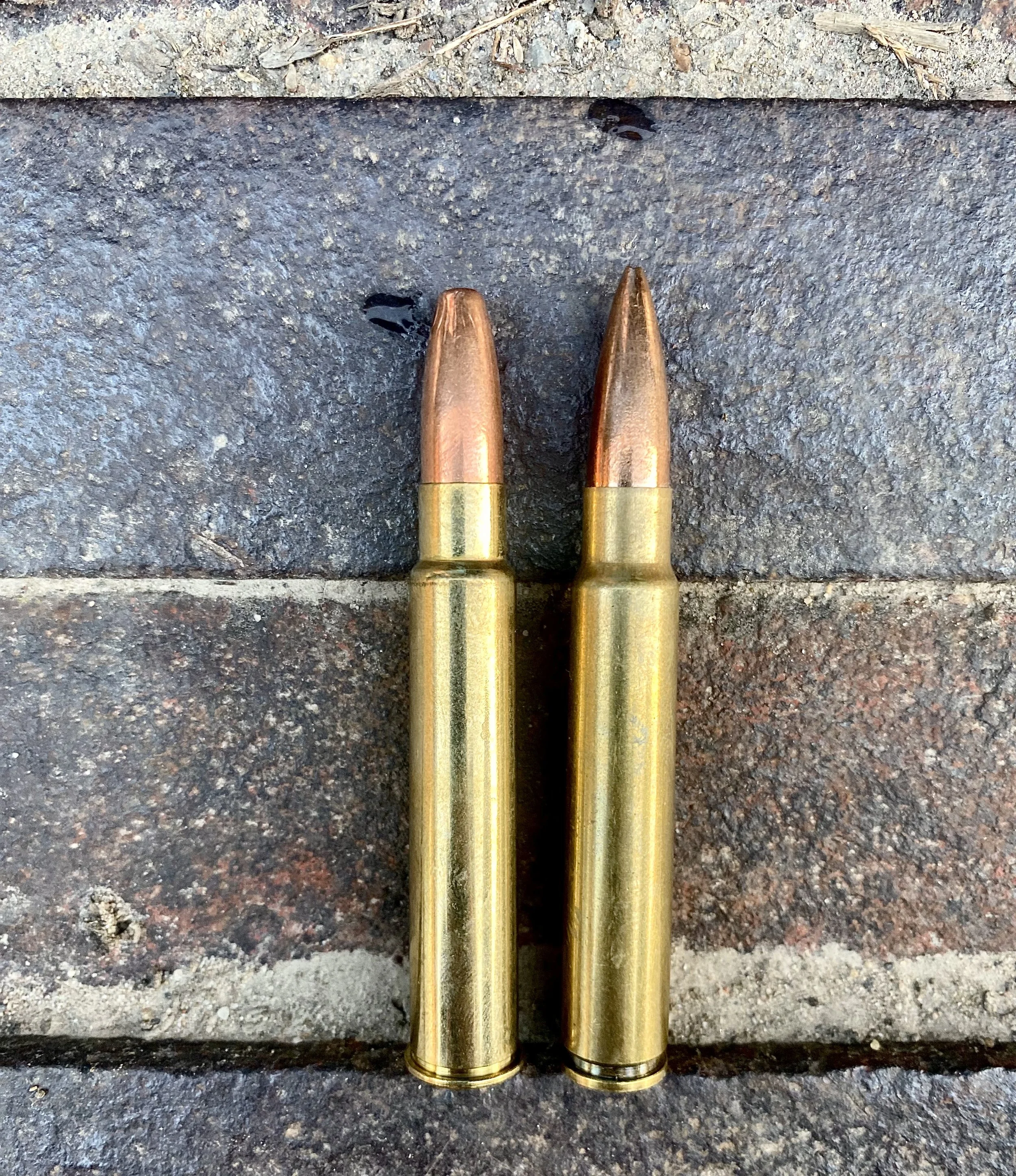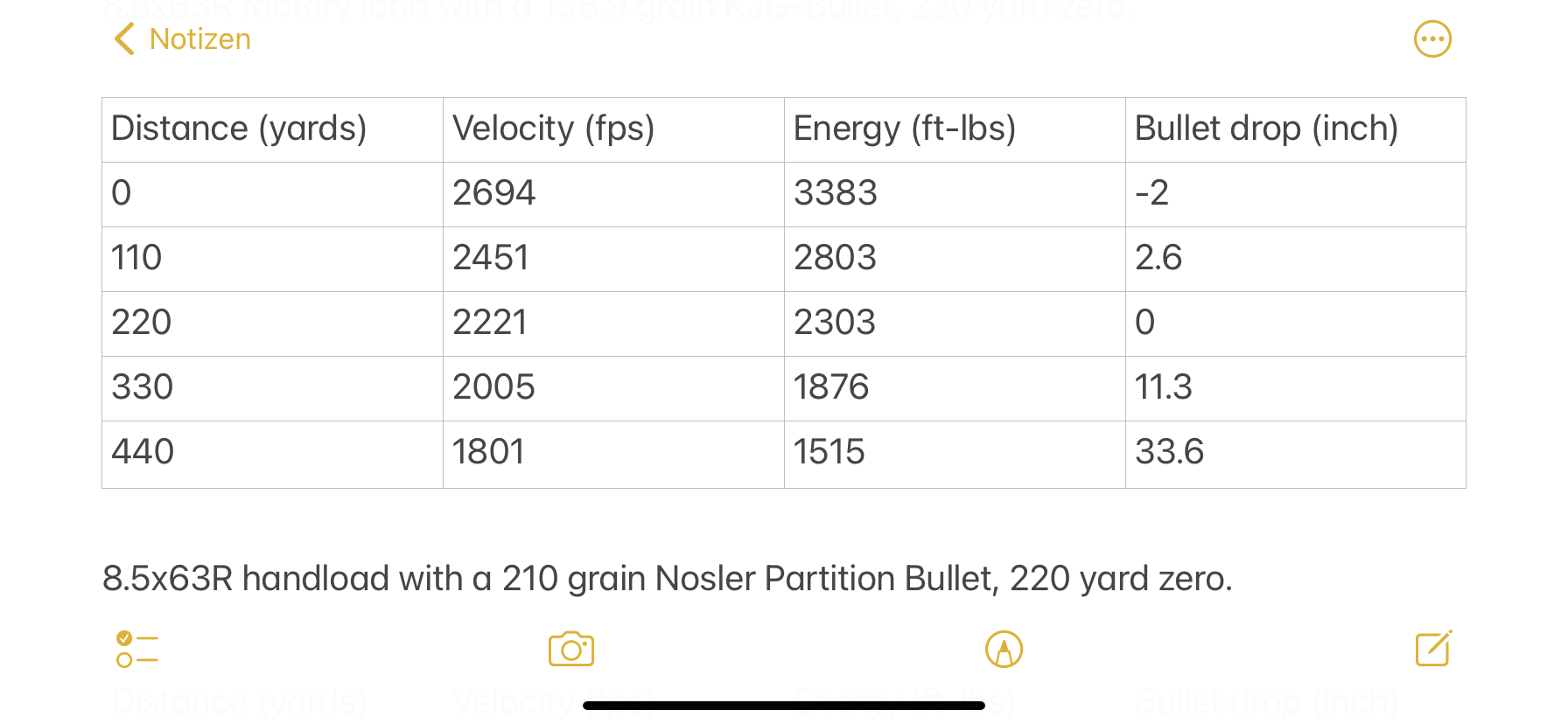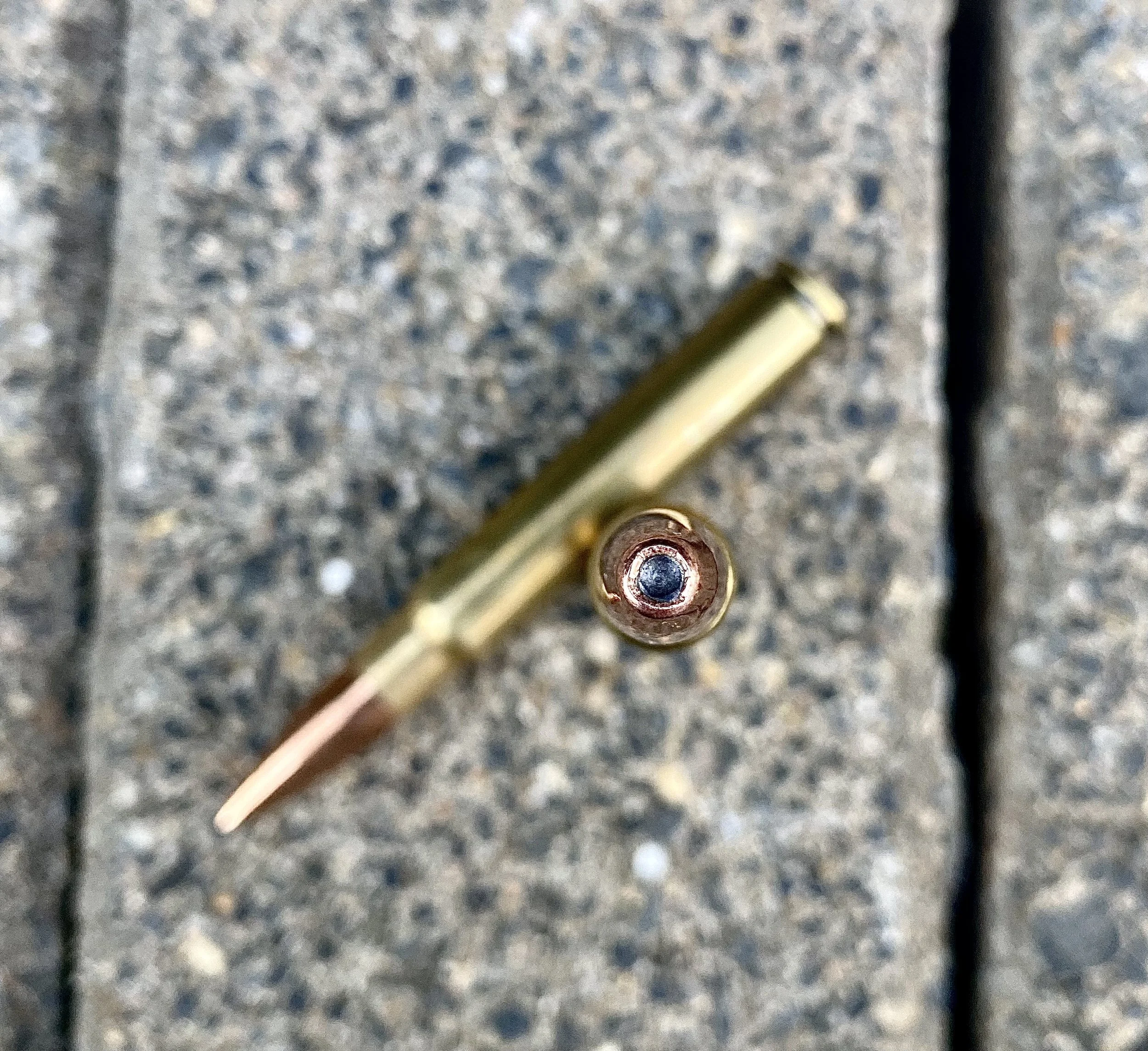8.5x63mm: A Rimmed Thumper for Heavy Critters
The .338 Winchester Magnum is one of the most recommended cartridges for bear hunters and guides in Alaska, I recently read. And I get why. It is easier to shoot quickly and accurately than bigger bore cartridges. But it’s also powerful enough to stop a charging bear when things go south. And especially for guides, whose main purpose is ironing out clients' mistakes or ending surprise encounters, quick and precise shots are desirable, to say the least. A bigger canon might feel better, but could prove useless if recoil is too heavy for good shot placement. A potent .338-caliber cartridge might be just right at balancing power and recoil.
8.5mm diameter bullets offer a lot of flexibility for bigger game.
The .338 Winchester Magnum is a cartridge built for bolt action rifles. Repeating rifles such as bolt guns offer a huge advantage when facing an angry apex predator or other dangerous game: a magazine full of lead to throw at an incoming fanged, clawed, or horned freight train. Contrary, African PH‘s often carry double rifles in rimmed cartridges for backup duties. I can see the wisdom in that approach, too, as no gun offers a quicker second shot than a double rifle. And it’s a fair question to ask how long an attacking bear will let you shoot at him. If you’ve not hit the bear right by the second round, you might have no time left to use the additional firepower from repeating guns. Autoloaders are as quick, obviously, but I wouldn’t bet my life on the function of one in wet and rust-promoting salty conditions.
Unfortunately, there are nowhere near as many rimmed .338 diameter cartridges as there are rimless ones. That’s the reason why there’s actually no true debate for North American hunters which set up to choose here.
Among the host of American .338 inch diameter cartridges, only two have a rimmed case. The .33 Winchester is the grandfather of all the .338 caliber cartridges. But neither can you find a ton of guns and ammunition, nor can it provide the level of performance most shooters and hunters desire in a .338 cartridge. Like so many good designs from yesteryear, it had its time. But that time seems to have passed, for the most part.
The other rimmed cartridge of this diameter is the .338 Marlin Express. A design specifically for lever guns, this cartridge is supposed to give .30-06 like ballistics from a lever action rifle. And it delivers, launching 200 grain Hornady Flex Tip bullets at about 2650 fps. That is more convincing to a heavy critter coming at you than the .33 Win, I guess. But it’s still not a .338 Win Mag.
For the shooter who desires a performance on par with the .338 Winchester Magnum, the standard round of this diameter, there is a definite void in the rimmed cartridge selection. Granted, the group of people begging for such a cartridge is probably small. But a more potent .338 inch diameter cartridge with a rimmed case might spark an interest in you regardless. Along with the mentioned break action double rifles (very reliable, easy to clean in adverse weather, but in their classic wood and blued steel configuration not made for salty and wet conditions, either), lever guns could digest a potent, rimmed .338 pill. Also, in continental Europe you’ll still find a lot of hunters toting combination guns, and a .338 caliber bullet is a sound choice for red stag and wild boar, too. So at least I see some purpose in such a cartridge.
German cartridge designer Werner Reb must have had the same opinion. He invented the 8.5x63mm R in the first half of the 1980’s to fill the gap between the 8x57mm IRS and the 9.3x74mm R (another good choice for big bodied animals) for break action guns. The parent case was the 7x65R. A rimless version followed, but that is too close to the .338 Win Mag to be something special. Both versions give comparable performance to the American standard design. So for this article, I will focus on the rimmed German cartridge.
The rimmed and the rimless version of the 8.5x63 cartridge.
As is usually the case with rare cartridges like the 8.5x63, you will not find many factory loads. German manufacturer Brennecke offers two loads for the rimless version, but none for the rimmed one. A smaller company named SAX-Ammunition offers a load for both. But for the most part, interested shooters would have to handload their own rounds. This is reality for many guides in Alaska or Canada anyway, but that needs to be considered. Components for handloading are readily available. Bullets of this diameter are especially widespread, and every type and form from simple cup and core to premium lead-free bullets are out there. Bullets are as light as 130 grains, as heavy as 300 grains. Pick your favorite. The 1 in 10 inch rifling twist of the 8.5x63 (the same as for the .338 Win Mag) should be able to stabilize most bullets. Cases can either be bought or they can be formed from 7x65R cases, which are also readily available in Europe.
To show you what kind of performance you can expect, I’d first like to give you the ballistics of the factory loaded SAX ammo with a light for caliber 138.9 grain (9 gram) KJG-Bullet (Kupfer Jagd Geschoss, which means copper hunting bullet), as advertised.
This is certainly not a load for dangerous game, but it could be a great choice for the longer distance shooting on combination hunts for bear and caribou, sheep or goat. Combined with a heavy load and knowledge of both trajectories this could work out great in bear country.
To gain a better impression of the cartridge's capabilities with more typical bullet weights, take a look at the numbers of a handload with a heavier 210 grain Nosler Partition. While this is not the ideal stopping bullet weight either, it is a good all round choice for many hunting purposes.
For reference, here are the ballistic numbers for the .338 Win Mag with a factory load from Federal using the same bullet.
As you can see, the American design is definitely more potent in this comparison. That is primarily due to the lower maximum chamber pressure (in this case 55,000 psi vs. 64,000 psi) many rimmed cartridges have, as they are fired from historically weaker actions. The difference will vary a little depending on different barrel lengths and specific loads. But the numbers should give you an idea of the capabilities of the rimmed 8.5x63mm cartridge. While the gap is not nothing for sure, most will agree that both cartridges play in the same ballpark. For such a low maximum pressure (at least to modern standards), the cartridge offers quite similar in-the-field performance. The lower pressure and the slower velocity will translate to less felt recoil, all other things being equal. So take that as a small advantage.
Many bullet types are available for 8.5mm/.338 inch bullets.
As mentioned in the beginning, cartridges of this power are a good choice for bears in North America. This includes even the biggest bears, but a gun chambered in 8.5x63 R would also be a good choice for baited or treed black bears. Matched with low powered scopes or open sights, there are few tools better for a task like that. Elk hunters and moose hunters would certainly appreciate the hard hitting characteristics of the .338 bullets, regardless of the case being rimmed or rimless. The same goes for hunts for big antelope in Africa or wild boar and red stags in South America, Europe, or New Zealand. While all these animals fall to smaller cartridges, there is nothing wrong with a bit more gun if the shooter can handle it.
Moose – even the cows – are big critters. There’s nothing wrong with a bit more bullet than a .30 caliber.
The hunter in search for a type of action other than a bolt action rifle should take a long look at this cartridge. A lever gun would probably have to be a custom rifle, maybe with a rotary magazine for the use of all bullet types. Some kind of break action rifle (single shot, double rifle or a combination with one or two shot barrels) pops up on the used gun market every now and then. But those guns chambered for the 8.5x63R are far from being a regular sight, even in Germany.
That may be the 8.5x63mm R’s biggest drawback. Like so many other good but obscure cartridges, it barely hangs on. Too many manufacturers build rifle after rifle for the top 10 popular cartridges, but little else. And who can blame them? They build what the market demands. But it’s unfortunate nonetheless. Little demand leads to few offerings leads to little demand. So having such a gun built for your specific needs might be your best option. For a bear guide, a double rifle or a lever gun in a weather-proof setup with stainless steel and synthetic stock will definitely work fine. Weather-proof coatings or laminated stocks widen the range of possible configurations. Doubles are easy to dissemble and clean in case of an accidental mud bath. That can pay huge dividends in dirty and wet environments.
Looking at all the facts, it’s easy to pass on the 8.5x63mmR and go straight to the .338 Win Mag. A bolt action rifle chambered for it will serve you well in any situation while being a whole lot more convenient than the German cartridge. But if you’re intrigued by the obscure – well, that might be reason enough to “roll your own” with an 8.5x63mm, rimmed or rimless. Dare to be different.








